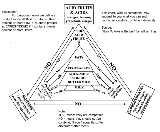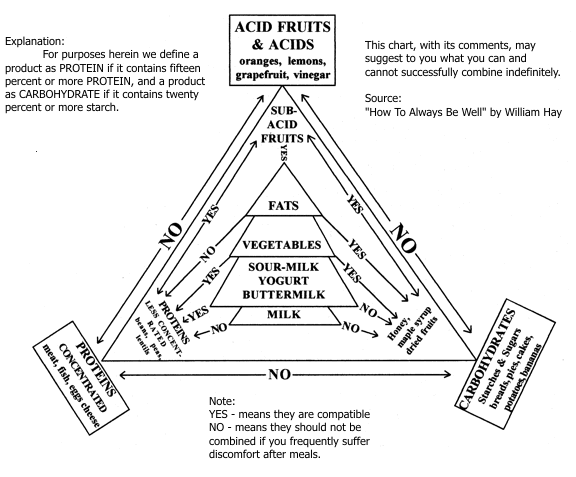
Dr. Hay diet
Encyclopedia
The Hay Diet is a nutrition method developed by the New York physician William Howard Hay
in the 1920s. It claims to work by separating food into three groups: alkali
ne, acid
ic, and neutral. (Hay's use of these terms does not completely conform to the scientific use, i.e., the pH
of the foods.) Acid foods are not combined with the alkaline ones. Acid foods are protein
rich, meat, fish, dairy, etc., and "alkaline" the carbohydrate
-rich starch foods like rice, grains and potatoes. It is also known as the food combining
diet.
A similar theory, called nutripathy, was developed by Gary A. Martin in the 1970s. Others who have promulgated alkaline-acid diets
include Edgar Cayce
, D. C. Jarvis
, Robert Young, Herman Aihara, and Victor A. Marcial-Vega.
 Dr. William Hay contracted Bright's disease
Dr. William Hay contracted Bright's disease
(or what modern medicine refers to as Nephritis
). Heart-dilated and near death, Dr. Hay began eating only natural foods; his calorie intake dropped and his health improved. Dr. Hay spent the following decade studying naturopathy and food combining to reduce the acid end-product of digestion. He found that fruits and vegetables produce an alkaline end-product when they are fully metabolized, while processed and refined foods left a high acidic environment after digestion. His theories went on to encompass food-combining; whereas incorrect combination would cause even alkaline foods to leave a less desirable acidic digestion end-product.
The Hay System promoted the practice of eating three meals per day with meal one being alkaline foods only, meal two protein foods with salads, vegetables and fruit, and meal three comprising starchy foods with salads, vegetables and sweet fruit. There should be an interval of 4.0 to 4.5 hours between each meal. However, in 1935, Dr. Stewart Baxter showed that the pancreas
secretes digestion enzymes simultaneously regardless of whether the food eaten is carbohydrates or protein.
American artist Man Ray
was a notable follower of the Hay Diet.
randomized clinical trial, which found no benefit from the diet in terms of weight loss.
A study by Golay et. al. comparing the effects on obese patients of a low-calorie diet comprising 25% protein, 47%
carbohydrates and 25% lipids (dissociated diet) and a 25% protein, 42% carbohydrates and 31% lipids (balanced diet) found no significant difference in the amount of weight loss in response to dissociated (6.2 +/- 0.6 kg) or balanced (7.5 +/- 0.4 kg) diets.
William Howard Hay
William Howard Hay, MD was a New York doctor, author, lecturer, and founder of The East Aurora Sun and Diet Sanatorium.A traditional physician for the first 16 years of his career, this New York doctor introduced the world to food combining, ran a successful sanatorium for many years , and was a...
in the 1920s. It claims to work by separating food into three groups: alkali
Alkali
In chemistry, an alkali is a basic, ionic salt of an alkali metal or alkaline earth metal element. Some authors also define an alkali as a base that dissolves in water. A solution of a soluble base has a pH greater than 7. The adjective alkaline is commonly used in English as a synonym for base,...
ne, acid
Acid
An acid is a substance which reacts with a base. Commonly, acids can be identified as tasting sour, reacting with metals such as calcium, and bases like sodium carbonate. Aqueous acids have a pH of less than 7, where an acid of lower pH is typically stronger, and turn blue litmus paper red...
ic, and neutral. (Hay's use of these terms does not completely conform to the scientific use, i.e., the pH
PH
In chemistry, pH is a measure of the acidity or basicity of an aqueous solution. Pure water is said to be neutral, with a pH close to 7.0 at . Solutions with a pH less than 7 are said to be acidic and solutions with a pH greater than 7 are basic or alkaline...
of the foods.) Acid foods are not combined with the alkaline ones. Acid foods are protein
Protein
Proteins are biochemical compounds consisting of one or more polypeptides typically folded into a globular or fibrous form, facilitating a biological function. A polypeptide is a single linear polymer chain of amino acids bonded together by peptide bonds between the carboxyl and amino groups of...
rich, meat, fish, dairy, etc., and "alkaline" the carbohydrate
Carbohydrate
A carbohydrate is an organic compound with the empirical formula ; that is, consists only of carbon, hydrogen, and oxygen, with a hydrogen:oxygen atom ratio of 2:1 . However, there are exceptions to this. One common example would be deoxyribose, a component of DNA, which has the empirical...
-rich starch foods like rice, grains and potatoes. It is also known as the food combining
Food combining
Food combining is a term for a nutritional approach that advocates specific combinations of foods as central to good health and weight loss...
diet.
A similar theory, called nutripathy, was developed by Gary A. Martin in the 1970s. Others who have promulgated alkaline-acid diets
Alkaline diet
The Alkaline diet is a diet based on the scientifically unsupported theory that certain foods, when consumed, leave an alkaline residue, or ash...
include Edgar Cayce
Edgar Cayce
Edgar Cayce was an American psychic who allegedly had the ability to give answers to questions on subjects such as healing or Atlantis while in a hypnotic trance...
, D. C. Jarvis
D. C. Jarvis
DeForest Clinton Jarvis was an American physician from Vermont. He is best known for his writings on the subject of folk medicine. He recommended a mixture of whole apple cider vinegar and honey that have variously been called switchel or honegar, as a health tonic...
, Robert Young, Herman Aihara, and Victor A. Marcial-Vega.
History

Bright's disease
Bright's disease is a historical classification of kidney diseases that would be described in modern medicine as acute or chronic nephritis. The term is no longer used, as diseases are now classified according to their more fully understood causes....
(or what modern medicine refers to as Nephritis
Nephritis
Nephritis is inflammation of the nephrons in the kidneys. The word "nephritis" was imported from Latin, which took it from Greek: νεφρίτιδα. The word comes from the Greek νεφρός - nephro- meaning "of the kidney" and -itis meaning "inflammation"....
). Heart-dilated and near death, Dr. Hay began eating only natural foods; his calorie intake dropped and his health improved. Dr. Hay spent the following decade studying naturopathy and food combining to reduce the acid end-product of digestion. He found that fruits and vegetables produce an alkaline end-product when they are fully metabolized, while processed and refined foods left a high acidic environment after digestion. His theories went on to encompass food-combining; whereas incorrect combination would cause even alkaline foods to leave a less desirable acidic digestion end-product.
The Hay System promoted the practice of eating three meals per day with meal one being alkaline foods only, meal two protein foods with salads, vegetables and fruit, and meal three comprising starchy foods with salads, vegetables and sweet fruit. There should be an interval of 4.0 to 4.5 hours between each meal. However, in 1935, Dr. Stewart Baxter showed that the pancreas
Pancreas
The pancreas is a gland organ in the digestive and endocrine system of vertebrates. It is both an endocrine gland producing several important hormones, including insulin, glucagon, and somatostatin, as well as a digestive organ, secreting pancreatic juice containing digestive enzymes that assist...
secretes digestion enzymes simultaneously regardless of whether the food eaten is carbohydrates or protein.
American artist Man Ray
Man Ray
Man Ray , born Emmanuel Radnitzky, was an American artist who spent most of his career in Paris, France. Perhaps best described simply as a modernist, he was a significant contributor to both the Dada and Surrealist movements, although his ties to each were informal...
was a notable follower of the Hay Diet.
Studies
The food-combining diet has been the subject of one peer-reviewedPeer review
Peer review is a process of self-regulation by a profession or a process of evaluation involving qualified individuals within the relevant field. Peer review methods are employed to maintain standards, improve performance and provide credibility...
randomized clinical trial, which found no benefit from the diet in terms of weight loss.
A study by Golay et. al. comparing the effects on obese patients of a low-calorie diet comprising 25% protein, 47%
carbohydrates and 25% lipids (dissociated diet) and a 25% protein, 42% carbohydrates and 31% lipids (balanced diet) found no significant difference in the amount of weight loss in response to dissociated (6.2 +/- 0.6 kg) or balanced (7.5 +/- 0.4 kg) diets.
External links
- Hay Diet page
- Health Via Food by Dr. Hay.
- Easy Healthy Diet

